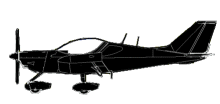
ASN Wikibase Occurrence # 177198
This information is added by users of ASN. Neither ASN nor the Flight Safety Foundation are responsible for the completeness or correctness of this information.
If you feel this information is incomplete or incorrect, you can submit corrected information.
| Date: | Sunday 21 June 2015 |
| Time: | 15:32 |
| Type: |  CSA PiperSport |
| Owner/operator: | Private |
| Registration: | N35EP |
| MSN: | P1001059 |
| Year of manufacture: | 2010 |
| Total airframe hrs: | 74 hours |
| Engine model: | Rotax 912 ULS |
| Fatalities: | Fatalities: 1 / Occupants: 1 |
| Aircraft damage: | Substantial |
| Category: | Accident |
| Location: | Near Topsail Airpark (01NC), Holly Ridge, NC -
 United States of America United States of America
|
| Phase: | Standing |
| Nature: | Private |
| Departure airport: | Holly Ridge, NC (01NC) |
| Jacksonville, NC (OAJ) | |
| Investigating agency: | NTSB |
| Confidence Rating: |
Earlier on the day of the accident, a condition inspection of the light-sport airplane had been completed, and the purpose of the flight was to relocate the airplane to its home base airport. About 1500, the pilot’s wife dropped the pilot off at the airport. The temperature was in the “upper 90s,” and, since the airplane was equipped with a clear cockpit canopy, it would have been hot inside of the airplane. According to the pilot’s wife, it was the pilot’s habit to leave the canopy up when it was hot until he was ready to depart.
About 1530, the pilot called his wife from the airplane before he took off and advised her that it would take him 15 minutes to fly to the home base airport and that he would wait for her to pick him up in the air-conditioned office of the fixed-base operator (FBO) at the field. However, when she arrived at the FBO, he was not there. A search was initiated, and the airplane wreckage was found in a wooded area about 1.1 miles west of the departure airport.
Recorded data downloaded from a portable GPS unit that was onboard the airplane revealed that the airplane was airborne about 1 minute before reaching a peak GPS altitude of 309 ft and a derived groundspeed of 104 knots. This was the final recorded position.
Examination of the accident site and wreckage revealed that the airplane struck trees in a steep, nose-low attitude and that the pilot was ejected from the cockpit. Examination of the damage to the canopy, the cockpit sill, and the canopy locking mechanism indicated that the canopy was not closed and locked when the airplane impacted the trees. This most likely occurred due to the pilot delaying closing of the canopy due to the high temperature (as was his habit) and then forgetting to lock it. Although the airplane’s Pilot’s Operating Handbook advised that the canopy could not be closed in flight and that there would be no change of flight characteristics with the canopy open, it is likely that the pilot was attempting to close the canopy in flight and lost control of the airplane, which resulted in an uncontrolled descent into the trees.
The pilot’s four-point harness was intact and attached to its attachment fittings; however, the center buckle assembly was found unlatched. This may have been the result of the pilot forgetting to buckle the harness, or he may have unlatched it so he could reach the canopy sill and/or the latching mechanism in an attempt to close the canopy in flight. Other indicators that the pilot may have been in a hurry to get airborne due to the high temperature included his failure to arm the emergency locator transmitter, which was found in the “off” position, and to remove the ballistic recovery system activation handle safety pin with its “REMOVE BEFORE FLIGHT” flag, which was found in place.
The pilot’s autopsy revealed that his heart was mildly enlarged, and his coronary arteries were significantly narrowed by atherosclerotic plaques. Microscopic evaluation of heart tissue also demonstrated mild interstitial fibrosis. Toxicological testing revealed medications that were consistent with the pilot’s heart disease. Although the pilot’s heart disease put him at risk for physical symptoms, such as chest pain, shortness of breath, or a heart rhythm that could not produce enough blood pressure to stay awake, neither the heart disease nor his medications would have impaired his judgment or increased his risk of becoming distracted by the canopy issue. Thus, the pilot’s medical conditions and medications most likely did not contribute to the cause of this accident.
Probable Cause: The pilot’s failure to maintain airplane control after the cockpit canopy opened during initial climb. Contributing to the accident was the pilot’s failure to securely lock the canopy before takeoff.
Accident investigation:
 |
|
Sources:
NTSB
FAA register: http://registry.faa.gov/aircraftinquiry/NNum_Results.aspx?NNumbertxt=35EP
Location
Revision history:
| Date/time | Contributor | Updates |
|---|---|---|
| 22-Jun-2015 17:38 | Geno | Added |
| 17-Jan-2016 17:32 | Anon. | Updated [Damage] |
| 21-Dec-2016 19:30 | ASN Update Bot | Updated [Time, Damage, Category, Investigating agency] |
| 19-Aug-2017 16:41 | ASN Update Bot | Updated [Time, Other fatalities, Nature, Departure airport, Destination airport, Source, Narrative] |
Corrections or additions? ... Edit this accident description
The Aviation Safety Network is an exclusive service provided by:


 ©2024 Flight Safety Foundation
©2024 Flight Safety Foundation